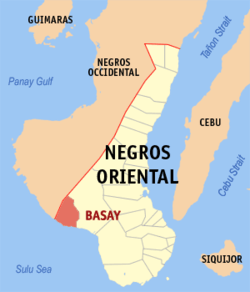Basay, Negros Oriental
| Basay | |
|---|---|
| Municipality | |
|
Municipal Hall of Basay | |
 Map of Negros Oriental with Basay highlighted | |
.svg.png) Basay Location within the Philippines | |
| Coordinates: 09°25′N 122°38′E / 9.417°N 122.633°ECoordinates: 09°25′N 122°38′E / 9.417°N 122.633°E | |
| Country | Philippines |
| Region | Negros Island Region (NIR/Region XVIII) |
| Province | Negros Oriental |
| Congr. district | 3rd district of Negros Oriental |
| Barangays | 10 |
| Government[1] | |
| • Mayor | Beda L. Canamaque |
| • Vice Mayor | Catherine Serion |
| Area[2] | |
| • Total | 162.00 km2 (62.55 sq mi) |
| Population (2010)[3] | |
| • Total | 24,913 |
| • Density | 150/km2 (400/sq mi) |
| Time zone | PST (UTC+8) |
| ZIP code | 6222 |
| Dialing code | 35 |
Basay is a fourth class municipality in the province of Negros Oriental, Philippines. According to the 2010 census, it has a population of 24,913 people.[3]
History

Upon its separation from Bayawan in 1971, Basay became Oriental Negros’ westernmost town, with Negros Occidental at its rear. Diocesan chronicles reveal that it was already a far-flung outpost in the nineteenth century. It perked up in the 70s when CDCP and INKO arrived to mine its copper and iron magnetite.
Basay is agricultural, with sugar cane, rice, corn and copra as major crops. Fringing its shoreline is the Mindanao Sea, considered the richest fishing waters in the country.
Three major rivers running parallel from north to south traverse the town. Balatong Point, also known as Punta Tambongon, was the landing site of a submarine bearing the biggest shipment of WWII ammunition for Negros Oriental. The party was headed by Col Jesus Villamor, acting on the personal direction of Gen Douglas McArthur who was then in Australia.
The coves and shallow caves on the shoreline of Nagbo-alao are said to be enchanted. The Negros cave frog is endemic to Basay. Its Pagatban River is home to the alligator. Bal-os and Cabcaban springs are important sources of potable water as well as sunny picnic sites. Yardahan is a fishing village with fine swimming areas and game-fishing activities.
Basay is approximately a two-hour-and-a-half drive from Dumaguete City.[4]
Barangays
Basay is politically subdivided into 10 barangays.[2]
- Actin
- Bal-os
- Bongalonan
- Cabalayongan
- Cabatuanan
- Linantayan
- Maglinao
- Nagbo-alao
- Olandao
- Poblacion
Demographics
| Population census of Basay | ||
|---|---|---|
| Year | Pop. | ±% p.a. |
| 1990 | 17,736 | — |
| 1995 | 18,500 | +0.79% |
| 2000 | 21,366 | +3.14% |
| 2007 | 22,713 | +0.85% |
| 2010 | 24,913 | +3.42% |
| Source: National Statistics Office[3] | ||
Education
Public Elementary Schools
- Basay Central Elementary School
- Bongalonan Elementary School
- Cabalayongan Elementary School
- Cabatuanan Elementary School
- Cabigti-an Elementary School
- Cleomenes Consolacion Fortugaleza Memorial Elementary School (Actin ES)
- Datag Elementary School
- Don Pablo Carmen Blanco Utzurrum Memorial Elementary School
- Maglinao Elementary School
- Monsale Elementary School
- Olandao Elementary School
Public High Schools[5]
- Actin National High School
- Bal-os National High School
- Basay National High School
- Maglinao National High School
References
- ↑ "Elected Mayors – Vice-Mayors and Councilors in Negros Oriental". Dumaguete.com. Retrieved 2016-05-15.
- 1 2 "Province: Negros Oriental". PSGC Interactive. Makati City, Philippines: National Statistical Coordination Board. Archived from the original on 23 May 2013. Retrieved 15 March 2013.
- 1 2 3 "Total Population by Province, City, Municipality and Barangay: as of May 1, 2010" (PDF). 2010 Census of Population and Housing. National Statistics Office. Archived from the original (PDF) on 9 March 2013. Retrieved 15 March 2013.
- ↑ "About | Cities & Towns", Negros Oriental Tourism Office. Retrieved 2013-05-28.
- ↑ "dumaguete.com".
External links
| Wikivoyage has a travel guide for Basay (Negros Oriental). |
- Philippine Standard Geographic Code
- Philippine Census Information
- Local Governance Performance Management System
 |
Hinoba-an, Negros Occidental | Ilog, Negros Occidental |  | |
| |
Bayawan | |||
| ||||
| | ||||
| Sulu Sea | |
Tulong Bay (Sulu Sea) |
